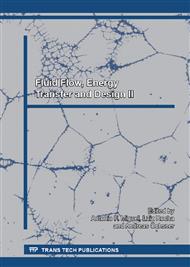p.92
p.100
p.108
p.115
p.172
p.190
p.200
p.209
p.224
Modelling of Bubble Growth in Supersaturated Solution Using Computational Fluid Dynamics - Population Balance Model (CFD-PBM) Approach
Abstract:
The bubble growth modelling in a supersaturated solution is difficult to be accomplished as it requires coupling of many interrelated hydrodynamics and mass transfer parameters which include pressure drop, supersaturation ratio, bubble size, etc. In the current work, all these factors have been taken into consideration to predict bubble growth in a supersaturated solution using Computational Fluid Dynamics (CFD) – Population Balance Model (PBM) approach. A classical bubble growth model has been used in the simulation. The bubble growth rate was successfully validated with experimental data in terms of bubble size. The attempt to simulate the bubble growth phenomenon of more than a single bubble condition has also been presented. The outcome of this approach is expected to be applied in many engineering areas.
Info:
Periodical:
Pages:
200-208
Citation:
Online since:
April 2015
Authors:
Keywords:
Price:
Сopyright:
© 2015 Trans Tech Publications Ltd. All Rights Reserved
Share:
Citation:


